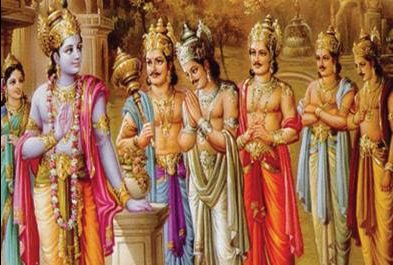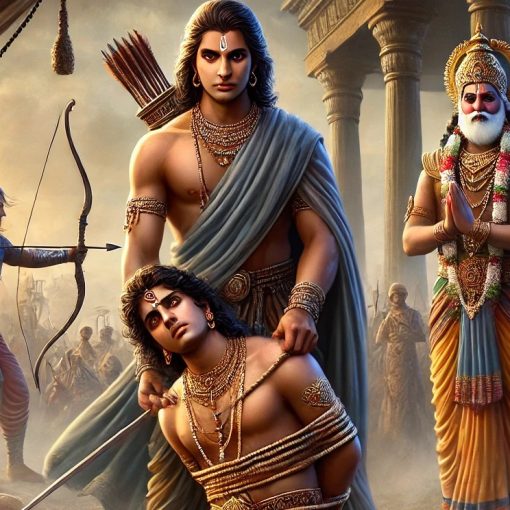In Chapter 17 of the Śrīmad-Bhāgavatam, titled “Punishment and Reward of Kali,” we see Mahārāja Parīkṣit firmly confronting Kali, the embodiment of sin and deceit. This chapter illustrates the king’s decisive action against the growing influence of Kali-yuga while simultaneously demonstrating compassion and spiritual intelligence. It underscores the importance of righteous governance and the balance between justice and mercy.
The Rise of Kali: A Challenge to Dharma
The chapter continues the confrontation between King Parīkṣit and Kali, who embodies the worst qualities of this age. After having been defeated and banished to five specific places, Kali reappears before Parīkṣit. The personified form of Kali humbly approaches the king, knowing he has no refuge except for the protection of a dharmic ruler.
Kali’s presence is not merely a physical manifestation but a metaphorical one as well. It signifies the rise of adharma—unrighteousness, hypocrisy, and sinful behavior that pervades the world. Kali-yuga, the Age of Quarrel, is characterized by the weakening of virtue and moral integrity, leading to the degradation of societal values.
Parīkṣit, as the protector of dharma, stands firm against this growing darkness, determined to curb the influence of adharma and protect his subjects from its insidious effects.
Lesson:
The emergence of Kali reminds us that adharma is not a distant threat but a persistent reality. Just as Parīkṣit confronts Kali with courage, we too must confront our own weaknesses—hypocrisy, deceit, and selfishness—by cultivating spiritual strength and remaining vigilant in upholding moral and ethical values.
Kali’s Request: Seeking Shelter in Parīkṣit’s Kingdom
Understanding that he has no choice but to obey Parīkṣit’s command, Kali humbly submits, saying that he has nowhere else to go. This is a pivotal moment that showcases the profound spiritual intelligence of Mahārāja Parīkṣit. Kali, though the embodiment of sin, is also a part of the Lord’s creation and, therefore, must be given shelter in accordance with dharma.
Realizing this, Parīkṣit allows Kali to reside in four specific places: gambling, intoxication, illicit sex, and animal slaughter. These four vices represent the primary gateways through which the influence of Kali spreads in society, leading to the degradation of human consciousness. Kali, however, cleverly requests a fifth place—gold, representing greed and economic corruption.
With a strategic mind, Parīkṣit permits this, aware that greed often triggers the other four vices, thereby amplifying the impact of Kali. The king’s decision to limit Kali’s presence to these five places reflects a profound understanding of human nature and spiritual dynamics.
Lesson:
Parīkṣit’s decision to confine Kali to specific vices teaches us about the importance of self-awareness. We must identify and confront the sources of temptation and vice in our own lives. By controlling where and how we engage with material activities, we can prevent the influence of Kali from gaining a foothold in our hearts and minds.
Gold and Greed: The Root of Degradation
Gold, symbolizing material wealth, becomes the fifth abode of Kali, indicating that greed is one of the most potent catalysts for spiritual downfall. It represents the lure of materialism that blinds people to ethical principles, spiritual duties, and compassion. The desire for wealth can lead to corruption, exploitation, and the loss of spiritual values.
In the modern context, this emphasis on material wealth resonates deeply. In today’s society, greed manifests not only in the pursuit of gold but also in the form of unethical business practices, financial manipulation, and consumerism. This has led to increased anxiety, dissatisfaction, and disconnection from spiritual life.
Lesson:
We learn from Parīkṣit’s confrontation with Kali that the pursuit of material wealth, when not tempered by spiritual wisdom and moral principles, can be highly destructive. As devotees, we should strive to manage wealth responsibly, using it as a tool for service to Krishna and the welfare of others rather than succumbing to greed.
Parīkṣit’s Righteous Rule: Upholding Dharma
Throughout this chapter, Mahārāja Parīkṣit is depicted as an ideal ruler who upholds dharma by ensuring that Kali is confined and controlled. Parīkṣit embodies the qualities of a rajarshi—a saintly king who blends administrative ability with spiritual insight. His actions reflect a profound understanding that ruling is not just about power but about protecting righteousness and promoting the well-being of all living beings.
Parīkṣit’s decisions are not merely administrative but are deeply rooted in his commitment to Krishna consciousness. He views himself as a servant of the Lord and considers the protection of dharma as part of his devotional duty. He understands that the age of Kali cannot be eliminated but can be contained and regulated.
Lesson:
Parīkṣit’s example teaches us that spiritual leadership involves wisdom, courage, and compassion. Whether in governance, family, or personal life, we must uphold spiritual principles even when faced with challenges. We must strive to be protectors of dharma by making decisions that align with divine will and benefit all beings.
The Four Pillars of Dharma: Truthfulness, Cleanliness, Mercy, and Austerity
This chapter also reminds us of the four pillars of dharma—truthfulness (satya), cleanliness (śauca), mercy (dayā), and austerity (tapaḥ). In Kali-yuga, these four pillars are weakened, with truthfulness being the last pillar still standing. This means that maintaining truthfulness becomes crucial in this age, as it is the foundation upon which spiritual growth and dharma depend.
The weakening of these pillars corresponds to the rise of the four vices in society, making it harder for individuals to practice spiritual discipline. However, bhakti-yoga, or the path of devotion, offers a powerful means to restore and reinforce these pillars within the heart. By engaging in devotional service, chanting the holy names of Krishna, and associating with sincere devotees, one can overcome the negative influences of Kali-yuga and strengthen the pillars of dharma within oneself.
Lesson:
The four pillars of dharma are essential for spiritual and moral integrity. We must consciously cultivate these virtues in our daily lives, understanding that they are the basis for spiritual advancement. Truthfulness, cleanliness, mercy, and austerity are not just moral ideals but vital practices that protect us from Kali’s influence.
Kali’s Defeat: A Temporary Victory for Dharma
Parīkṣit’s temporary victory over Kali is symbolic of the ongoing battle between dharma and adharma. While Parīkṣit is successful in containing Kali, the age of Kali continues to advance, as ordained by time. This reflects the reality that the material world is inherently impermanent, and that dharma, while powerful, must be continually protected and nurtured.
The chapter’s conclusion emphasizes that the real victory lies not in external control but in the inner transformation of the heart through bhakti. While Parīkṣit’s actions offer a brief reprieve from the forces of Kali, the real solution to the challenges of Kali-yuga is devotional service—the path of chanting, hearing, and serving Krishna. Only by turning to Krishna can one truly transcend the negative influences of the age and attain spiritual peace and happiness.
Lesson:
The confrontation between Parīkṣit and Kali illustrates the transitory nature of material victories. True and lasting transformation occurs only through surrender to Krishna and deepening one’s devotional practices. We must focus on cultivating bhakti as the ultimate means to transcend Kali’s influence.
Practical Application: Living with Bhakti in Kali-yuga
The lessons of this chapter offer practical guidance for navigating life in Kali-yuga:
- Guard against the Four Vices: Like Parīkṣit, identify and limit the influence of gambling, intoxication, illicit sex, and animal slaughter in your life. Practice self-discipline and engage in activities that foster spiritual growth.
- Value Truthfulness: Be truthful in all your dealings, knowing that it is the last standing pillar of dharma in Kali-yuga. Truthfulness is the foundation of trust, integrity, and spiritual progress.
- Use Wealth Wisely: Understand that while wealth is necessary, it should be used for service to Krishna and the well-being of others. Avoid becoming attached to material possessions and remain focused on spiritual goals.
- Strengthen Bhakti Practices: Engage regularly in chanting the holy names, studying the scriptures, and associating with devotees. Bhakti-yoga is the most potent means to overcome the corrupting influence of Kali-yuga.
- Embrace Spiritual Leadership: Like Parīkṣit, strive to be a leader who protects and promotes dharma. Whether in family, community, or personal life, lead by example and inspire others through your actions.
Lesson:
The practical application of these principles requires consistent effort, dedication, and guidance. However, even small steps toward spiritual discipline can have a profound impact, both individually and collectively.
Conclusion: The Path of Bhakti in Kali-yuga
Chapter 17 of the Śrīmad-Bhāgavatam illustrates the complexities of living in Kali-yuga while providing a roadmap for spiritual survival. Through Mahārāja Parīkṣit’s confrontation with Kali, we learn the importance of spiritual vigilance, strategic thinking, and unwavering commitment to dharma.
The chapter ultimately teaches that while Kali-yuga is fraught with challenges, it also offers unparalleled opportunities for spiritual advancement through the practice of bhakti-yoga. By embracing the holy name, the association of devotees, and the teachings of the Bhāgavatam, we can rise above the darkness of the age and find spiritual fulfillment and liberation.
Let us draw inspiration from Parīkṣit’s courage, wisdom, and devotion as we face the challenges of our own lives. With Krishna in our hearts and the Bhāgavatam as our guide, we can navigate Kali-yuga with confidence, purpose, and joy.





